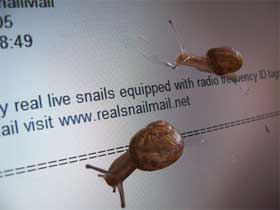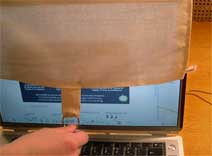 RealSnailMail is a project currently developed by boredomresearch. The system uses real snails with pet RFID chips glued to their shells to carry and deliver electronic messages on their own time, despite growing expectations of instant communication.
RealSnailMail is a project currently developed by boredomresearch. The system uses real snails with pet RFID chips glued to their shells to carry and deliver electronic messages on their own time, despite growing expectations of instant communication.
Commissioned as part of the Tagged exhibition in London, the launch of the project will constitute of a projection in the space gallery is a computer model created by boredomresearch, enabling them to test components they will need to build 'RealSnailMail'.
Eventually this system will be built into an installation version in 2007/08. You can visit the Real Snail Mail website and send a message which travels to a server where it is entered into a queue. Here it waits until a snail wonders in range of a hot spot. The hot spot is the dispatch centre in the form of a RFID reader. This reader identifies the snail from its chip and checks to see if it has not already been assigned a message to carry. If the snail is available it is assigned the message at the top of the list. It then slips away into the technological wasteland. Located at the other end of the pond (in the case of aquatic snails) is the drop off point. When, or if, the snail ever makes it here, it is identified by another reader, which then forwards the relevant message to the recipients email address; once again travelling at the speed of light.
The tagged exhibition runs until 21 Oct., at Space Triange, in London. The artists will give a talk tonight 7PM at [ s p a c e ].
Also by boredomresearch: Theatre of Restless Automata.
Talking about slowing the web:
Louise Klinker's SLOWEB project that responds to peoples' obsession with speed and efficiency when using computers.
What does it mean when you have to queue to enter a website? And does it feel special to know that you are the only one using a service like Google at that time?


SLOWEB offers peripherals for the computer: a blind for the screen and a coffee mug to use as a mouse. SLOWEB also offers two computer applications: a special slow mail service that provides extra information about how long the author took to write it and is also concerned with the geographical relationship between author and receiver and a unique version of Google that requires you to queue if you want to enter a website.
And there's also SLOWmail by Carolyn Strauss and Julian Bleecker from slowLab. This project has been awarded one of the Rhizome 2006/2007 commissions. The email service would deliberately slow down the pace of electronic messaging, offering a more reflective experience for both sender and recipient, and challenging forth more artful, writerly and meaning-ful correspondence.
The author tags his correspondence to describe a relationship to the recipient, their respective geographic locations and the mood of the message. The message is then filtered through the SLOWmail software environment which further interprets its meaning and assesses the sender-recipient relationship, factoring in message history, frequency of correspondence and past message content to determine the delivery timeframe.
At any time, users may login to the SLOWmail web site to view messages in progress, experienced as compelling graphic visualizations that develop gradually to represent pending correspondence.

